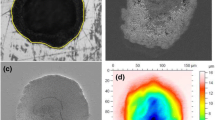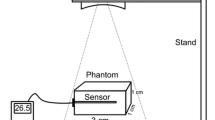Abstract
Purpose
Silicon carbide (SiC) is an inert compound material with excellent microwave absorption and heat-conducting properties. The aim of our study was to investigate the heat-enhancing effects of SiC in microwave ablation in an in vitro setting.
Materials and Methods
Different concentrations of SiC powder were mixed with 2% gelatin, producing a 20-ml mixture that was then heated with a clinical microwave ablation system (5 min/45 W). Temperature was measured continuously fiberoptically. Additional heating properties were assessed for the most heatable concentrations at different energy settings (10, 20, and 30 W). As reference, 2% gelatin without SiC was heated. Statistical evaluation by analysis of variance with post hoc Student–Newman–Keuls testing was performed.
Results
For the different SiC concentrations, maximum temperatures measured were 45.7 ± 1.2°C (0% SiC, control), 50.4 ± 3.6°C (2% SiC), 60.8 ± 1.8°C (10% SiC), 74.9 ± 2.6°C (20% SiC), and 83.4 ± 2.5°C (50% SiC). Differences between all data points were significant (P < 0.05). Maximum temperatures that used 20% SiC were 36.3 ± 2.76°C (10 W), 48.7 ± 4.18°C (20 W), and 50.6 ± 0.68°C (30 W). The use of 50% SiC maximum temperatures resulted in values of 46.2 ± 2.52°C (10 W), 70.1 ± 0.64°C (20 W), and 83.0 ± 4.69°C (30 W). With 20% SiC and 50% SiC mixtures, the 10 W maximum temperatures were significantly lower than at all other power levels, and maximum temperatures with 20 and 30 W were significantly lower when compared with 45 W (P < 0.05).
Conclusions
SiC is a nontoxic, highly effective substance for enhancing microwave-induced heating with a microwave ablation system in vitro. These data suggest its usefulness for enhancement of ablative effects in percutaneous tumor therapy. Further investigations need to be performed to evaluate the ex vivo and in vivo ablation effects and the possible methods for administration of SiC particles.





Similar content being viewed by others
References
Curley SA, Izzo F, Ellis LM et al (2000) Radiofrequency ablation of hepatocellular cancer in 110 patients with cirrhosis. Ann Surg 232:381–391
Lencioni R, Cioni D, Bartolozzi C (2001) Percutaneous radiofrequency thermal ablation of liver malignancies: techniques, indications, imaging findings, and clinical results. Abdom Imaging 26:345–360
Mahnken AH, Bruners P, Günther RW (2009) Local ablative therapies in HCC: percutaneous ethanol injection and radiofrequency ablation. Dig Dis 27:148–156
Simon CJ, Dupuy DE, Mayo-Smith WW (2005) Microwave ablation: principles and applications. Radiographics 25(suppl 1):S69–S83
Isfort P, Bruners P, Penzkofer T, Gunther RW et al (2010) In vitro experiments on fluid-modulated microwave ablation. Rofo 182:518–524
Kremsner JM, Kappe CO (2006) Silicon carbide passive heating elements in microwave-assisted organic synthesis. J Org Chem 71:4651–4658
O’Sullivan DPMJ, S Hampshire, Murtagh MJ (2004) Degradation resistance of silicon carbide diesel particulate filters to diesel fuel ash deposits. J Mater Res 19:2913–2921
Bruch J, Rehn B, Song W et al (1993) Toxicological investigations on silicon carbide. 2. In vitro cell tests and long term injection tests. Br J Ind Med 50:807–813
Roberts BA, Strauss CR (2005) Toward rapid, “green”, predictable microwave-assisted synthesis. Acc Chem Res 38:653–661
Misselt AJ, Edelman TL, Choi JH et al (2009) A hydrophobic gel phantom for study of thermochemical ablation: initial results using a weak acid and weak base. J Vasc Interv Radiol 20:1352–1358
Bruners P, Hodenius M, Günther RW et al (2007) Fluid-modulated RF ablation: in vitro experiments. Rofo 179:380–386
Goldberg SN, Ahmed M, Gazelle GS et al (2001) Radio-frequency thermal ablation with NaCl solution injection: effect of electrical conductivity on tissue heating and coagulation—phantom and porcine liver study. Radiology 219:157–165
Livraghi T, Goldberg SN, Monti F et al (1997) Saline-enhanced radio-frequency tissue ablation in the treatment of liver metastases. Radiology 202:205–210
Lubienski A, Dux M, Lubienski K et al (2005) Radiofrequency thermal ablation: increase in lesion diameter with continuous acetic acid infusion. Cardiovasc Intervent Radiol 28:789–794
Bai ZYC, Bharti V, Xu HS, Zhanga QM (2000) High-dielectric-constant ceramic-powder polymer composites. Appl Phys Lett 76:3804–3806
Schwartz M, Weintraub J (2008) Combined transarterial chemoembolization and radiofrequency ablation for hepatocellular carcinoma. Nat Clin Pract Oncol 5:630–631
Baeraky T (2002) Microwave measurements of the dielectric properties of silicon carbide at high temperature. Egypt J Solids 25:263–273
Conflict of interest
The authors declare that they have no conflict of interest.
Author information
Authors and Affiliations
Corresponding author
Rights and permissions
About this article
Cite this article
Isfort, P., Penzkofer, T., Pfaff, E. et al. Silicon Carbide as a Heat-enhancing Agent in Microwave Ablation: In Vitro Experiments. Cardiovasc Intervent Radiol 34, 833–838 (2011). https://doi.org/10.1007/s00270-010-0033-6
Received:
Accepted:
Published:
Issue Date:
DOI: https://doi.org/10.1007/s00270-010-0033-6




